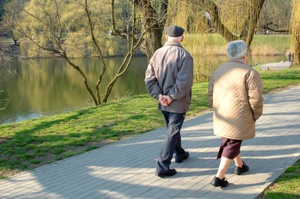- Be aware of where and when you walk
- In the evenings, walk where there is plenty of light to help you see where you are going.
- If you see a tree ahead in your path, look for fallen leaves or tree roots that might push up the sidewalk.
- Watch out for cracks in sidewalks, holes, and changes in sidewalk levels.
- Be extra careful during and after stormy weather. Rain, snow, and ice can make any surface slippery.
- Be sure you are wearing the correct eyewear while walking. Bifocals or reading glasses make it harder to see hazards on the ground. Wear sunglasses on bright days to reduce glare.
- Tips for physical activity
- When walking for exercise, consider going to well-maintained places such as the mall or the track at a local high school.
- Walk in pairs or groups so you can alert each other of potential hazards.
- Wear shoes with firm soles and low heels. Make sure to wear sturdy shoes when exercising.
- Travel safely
- Hold hand rails and move slowly when climbing outdoor stairs.
- Use caution in parking lots and parking garages. Be aware of curbs, car stops, and changes in elevation.
- While riding public transportation such as buses and trains, always use handrails when available.
- When crossing the street, walk in crosswalks and use curb cuts or ramps when they are present. Stop at islands in the middle of the street when available and wait for the next walk sign.
- Always take your time – hurrying across streets puts you at risk of falling.

